The ASUS ZenPad S (Z580CA) Review
by Brandon Chester on August 31, 2015 8:00 AM ESTGPU Performance
Rather than using Intel’s HD series iGPUs, the Atom Z3530 and Z3580 SoCs in both versions of the ZenPad S use Imagination Technologies’ PowerVR G6430 GPU. Since this implementation is identical to the one in the ZenFone 2 it’s not likely we’ll see a large gap in absolute performance. However, the larger chassis of the ZenPad may allow it to dissipate heat more effectively, which could help performance in long-term sustained workloads. It’s also worth noting that the less expensive Atom Z3530 model of the ZenPad S will suffer from reduced performance in GPU heavy workloads due to the 1GHz reduction in max CPU clock compared to the $299 model, as well as the drop in GPU speed from 533MHz to 457MHz.
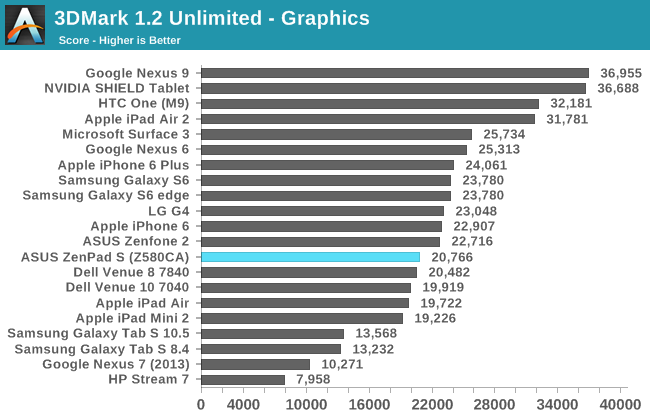

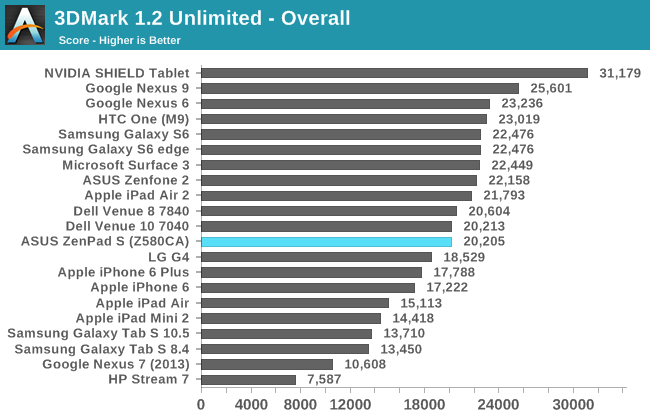
In 3DMark we actually see a noticeable gap between the ZenPad S and the ZenFone 2. The latter ends up scoring around 2000 points higher in both sub-tests, which leads to an overall score which is also around 2000 points higher. I would mostly attribute this to software differences rather than any issues with throttling, and the next tests will help to confirm that assumption.
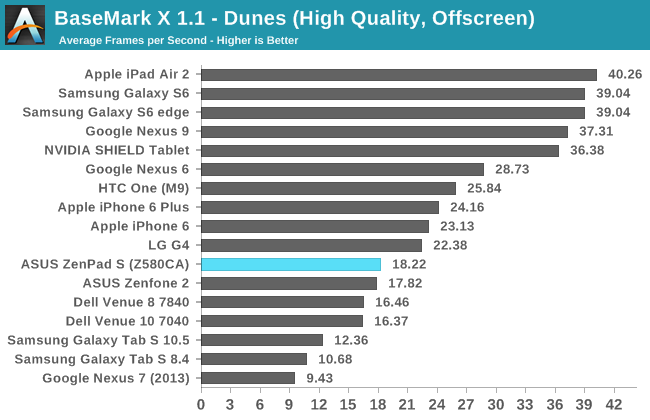
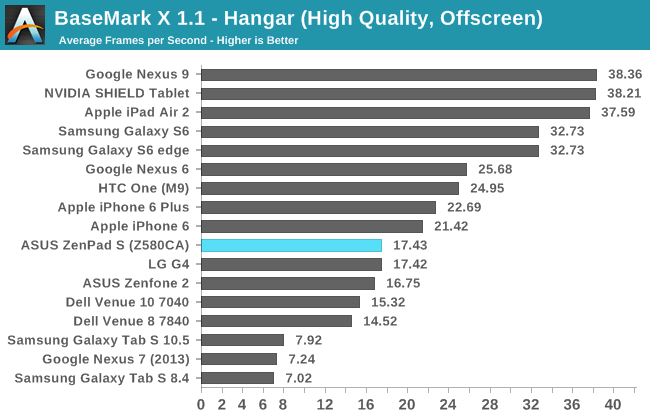
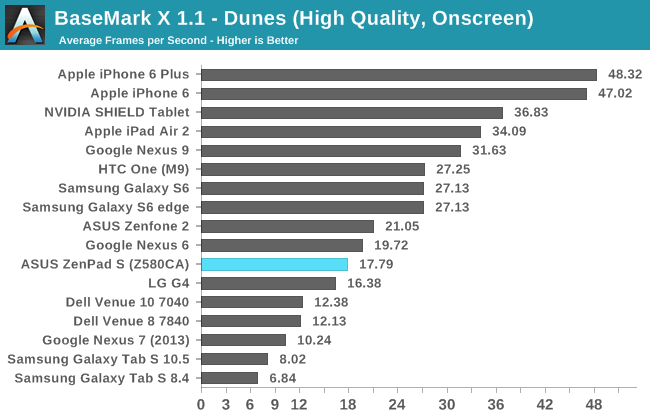
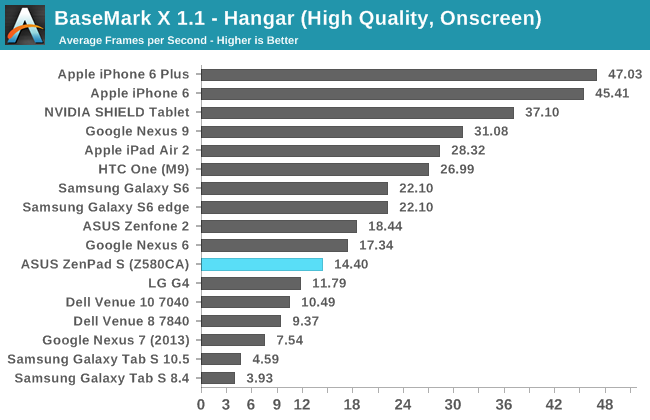
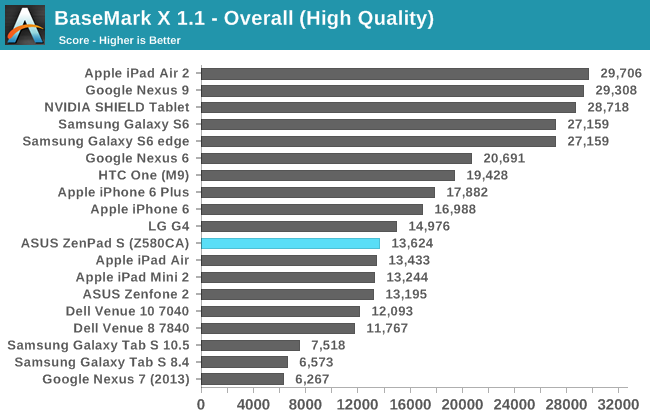
The ZenPad S doesn’t perform as well as the ZenFone 2 in BaseMark X’s on screen tests, which isn’t surprising given that it’s pushing 1.6 million more pixels. In the off screen tests we see both devices perform roughly equally, and this is reflected in the overall score. In other reviews, such as my review of the Dell Venue 8 and Venue 10 I mentioned that G6430 is a bit slow compared to the competition at that price point. For a $299 it fits perfectly, and coincidentally a lower clocked version of it is what’s used in the iPad Mini 2 which is also $299.

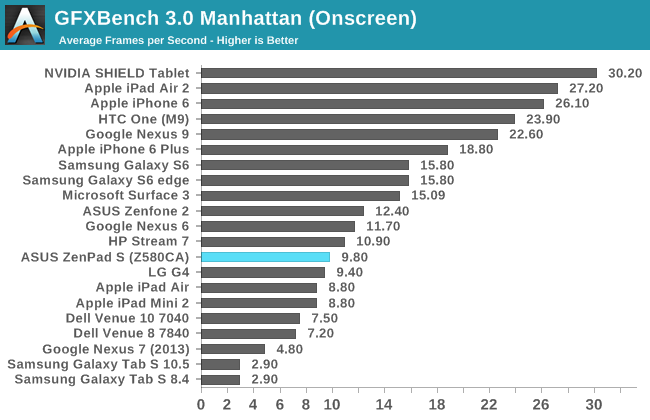
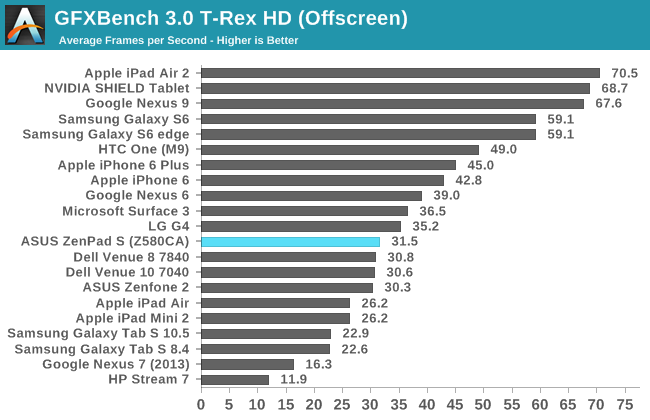
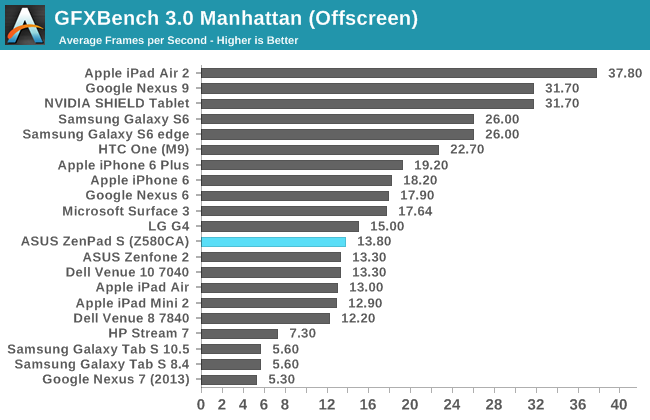
In GFXBench we again see the ZenPad S performs worse than the ZenFone 2 at its native resolution, but the overall GPU power of the two devices is equal. Like the Venue 8 and Venue 10, the PowerVR G6430 implementation in Atom Z3580 outperforms Apple’s A7 by a significant degree in the T-Rex HD test, but not in any other.
It’s clear from our tests that the GPU performance of the ZenPad S Z580CA is roughly the same as Apple’s iPad Mini 2. Since both devices have the same price, the ZenPad S is right where it needs to be in this regard. Performance in programs running at a device’s native resolution will obviously be slower than the ZenFone 2 due to the ZenPad S’s higher resolution, but I think G6430 provides more than adequate performance to run the display, and is the best you’ll be able to find in a $299 device right now.
NAND Performance
The performance of a mobile device's internal storage can have a significant impact on performance. When any applications are performing reads or writes in the background, a low NAND solution can cause the tasks the user is currently performing to grind to a halt. On top of that, there are fairly obvious implications for the time it takes to move music, movies, pictures, and other media to and from the device.
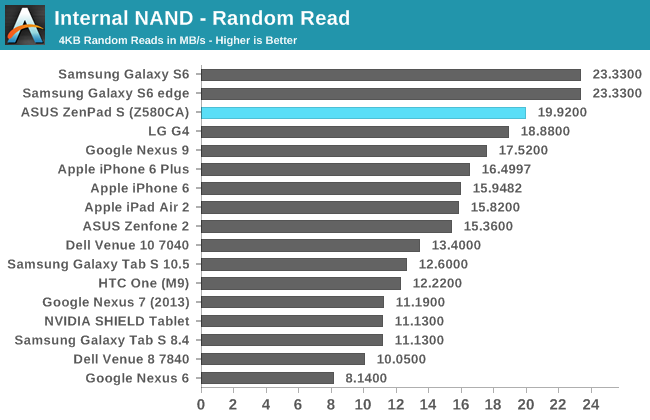
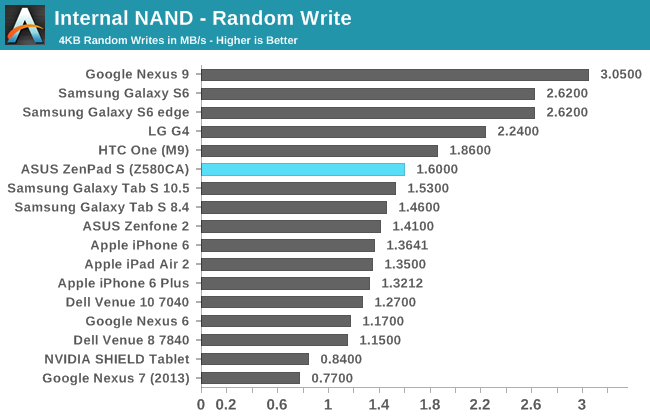
Both random read and random write speeds on the ZenPad S are very good for a mobile device. In both cases it ends up being the fastest tablet on record.
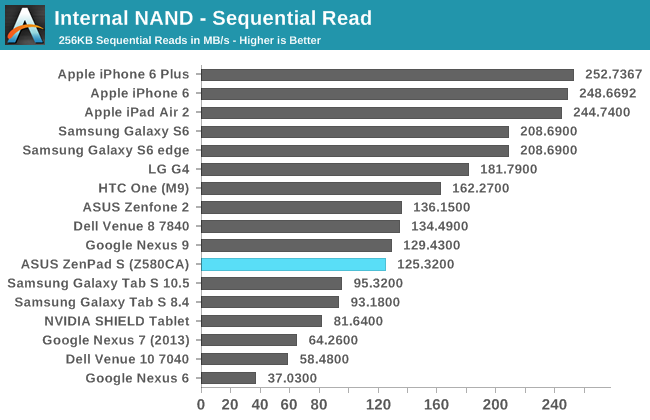
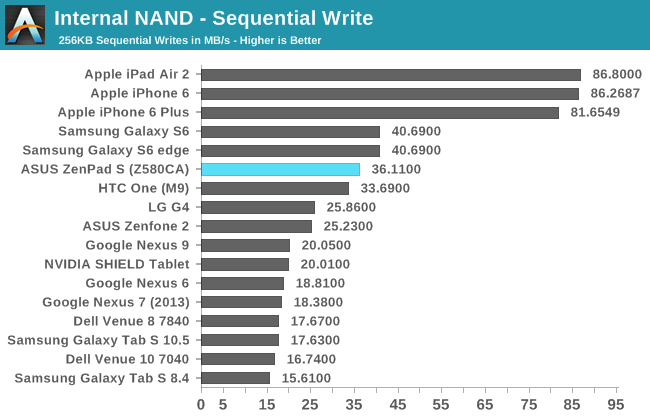
The sequential read speed on the ZenPad S is good for a $299 device, and the sequential write speed is actually the fastest we've seen in an Android tablet. However, it's disappointing to see that Android devices can now adopt USB 3.0 without terrible connectors by using USB Type-C, yet they still have NAND that won't even saturate a USB 2.0 link in the best possible scenario. Relative to the NAND in other Android devices the ZenPad S performs well, but the speed of eMMC flash memory still leaves much to be desired.










114 Comments
View All Comments
Shadow7037932 - Monday, August 31, 2015 - link
Man, that's disappointing. I was hoping more value like the Zenfone 2.MrSavage - Monday, August 31, 2015 - link
More value like what? Put a 16GB storage along with 1GB of RAM like the iPad mini 2 (as mentioned endlessly in this review) and don't you think it would cost less than $199? So then the Z580CA would be price around $199 or less, and the 2 year old iPad mini 2 would be $100 more. Oh yes, more value please. Afterall, let's compare apples with oranges. Zenfone 2 value? So a 8-inch display for a price similar to a 5.5-inch display device. Put stylus support into the Zenfone 2 and what would that cost?Kepe - Monday, August 31, 2015 - link
Does ASUS pay you to troll around here, praising the Zenpad and dissing everyone who finds the product a bit disappointing? Price doesn't matter at all if the product fails on too many categories that would have been rather easy to fix. This thing has too many software issues, such as artificially oversharpening everything on the display (makes small text hard to read for example), always on CABC and poor camera image processing.Cheap price alone isn't enough to justify the problems this thing has. You wouldn't buy a badly made and designed car even if it was 30% cheaper than the competing, well-made and thought of car.
Of course cheap price doesn't always mean something is bad. Look at OnePlus 1 and 2 and the new Moto X. They're half the price of the competition, but you couldn't tell that by the spec sheets or how they are made and what materials are used. Those are good examples of how to make a cheap product in an intelligent and thoughtful way.
MrSavage - Monday, August 31, 2015 - link
Hey friend. I think it's okay to challenge people or to question logic. You don't logically compare a smartphone with a tablet. Do you? I would expect a $100,000 car to be on a level playing field as a $20,000 car. I wouldn't compare the Z380CA to an iPad mini 2 because if you removed 3GB of RAM, put in a slower processor, and removed 32GB of storage then the Z580CA would be priced around $200 don't you think? Compare apples with apples is logical. You don't own one so I would suspect you don't have any credibility on what the Z580CA has or doesn't have. With a weak review, things can and should be corrected by people who know better in the comment section. You can always always always get more bang for your buck. Apple proves that. To me the failure is partially on Asus for sending an early review unit that OBVIOUSLY needed a firmware update prior to publisher, and beyond that, one key component the Z stylus isn't even available for those reviews. I'm expressing my opinion to clear up some of the ignorance out there.Kepe - Monday, August 31, 2015 - link
You are not making any sense at all. The iPad mini 2 and the Z580CA cost exactly the same amount of money: $299. That is why they can and should be compared. The iPad mini 2 is 2 years old, that's why it has less ram, storage, slower processor and such.Somewhere else in the comments you said people shouldn't compare the Z580CA to a Samsung tablet because it was $100 more expensive. Now you say people shouldn't compare devices that cost the same. What the heck are we supposed to compare, then? Two Z580CA's and look at them with a microscope to spot some differences in the surface texture and then compare them?
Besides, I haven't been comparing a tablet to a phone. The charts in the review have phones as well because they use the same SOCs (processors, GPUs).
The reason graphs and charts are used and detailed measurements are taken (display, performance, specs) is to remove objectivity from the results. Without them, every review would be like this:
"The display is ok I guess. There wasn't any significant UI lag. Gaming was ok. Weight is ok, not too heavy. Battery lasted for quite a while. It's an ok tablet I guess."
That kind of a review doesn't benefit anyone. The only way to properly decide which device is better at which thing is to measure those things, put them in a chart and compare them. As a reader, you should have the brain capacity to understand the price and other differences by yourself. We all know that the Zenpad reviewed here costs $299 and some other devices in the charts are more expensive and some are less expensive. It's up to the reader to decide what kind of price/performance he or she wants. It's the same thing with GPU reviews. The charts have old GPUs, new GPUs, cheap GPUs, expensive GPUs all in one. It isn't unfair, because everyone understands that the cheap ones won't be as fast as the new ones, and the expensive old ones won't be as fast as expensive new ones. You have to use your own brains when you're reading.
MrSavage - Monday, August 31, 2015 - link
I can appreciate what you're saying. I'm not trying to argue with you, only to discuss. Let me clarify. Similar price is fair, so long as the specs match up. The ipad mini 2 and Z580CA are total apples and oranges. It's not an equal value trade off at all. If you strip most of the things I mentioned, then you will have a true value comparison.The reason the new Samsung Tab S2 is worth comparing is because they are comparable spec wise, except for the storage and a bit of RAM. The value proposition of the Z580CA exceeds the negatives, but that's my opinion.
Charts and graphs have some value, so I'm not disregarding those entirely. Obviously anandtech is very reliant on their data and that's fine. Perhaps the audience reading the review will figure things out on their own, but it's a false assumption to assume that people understand the technicalities. I don't disagree that people need to use their brains when analyzing data or stats. Some stats however are statistically insignificant and that's why I take issue with some of those devices listed.
Those best review is one that looks realistically at the cost/value proposition. Everything out there sucks in the tablet category against the iPad Air 2. Beyond that, the review here of the display is sporadic and unclear. If it's software? If it was patched at some point during the review? That should not be made as an aside. It's not clear to me if the issues were resolved with the update and that essentially nullified most of the previous complaints being made about the display. Just not good enough in my books. Beyond that, it's never a good idea to trust one review and make a decision or judgement based on that.
BurntMyBacon - Wednesday, September 2, 2015 - link
Let me try to word it a different way. For the same price you get an extra 3GB of RAM, a faster processor, and an extra 32GB of storage. If those things are of highest importance to you, then this equates to more value. However, if your personal priorities dictate that use of iOS, Apple branding, build quality, display quality, etc. are more important, then perhaps you come to a different conclusion.LoganPowell - Friday, November 27, 2015 - link
Unfortunately Asus Zenpad Z580CA ranks rather poorly among top rankings (see ranking http://www.consumerrunner.com/top-10-best-tablets/ for example...)BurntMyBacon - Wednesday, September 2, 2015 - link
@Kepe: It doesn't matter if the iPad Mini 2 is two years old. That doesn't make it suddenly a better value. Either the price needs to drop accordingly, or a newer updated version needs to hit the market. Of course, you may find it a better value given other characteristics, but that depends on your priorities.Puck85 - Thursday, September 10, 2015 - link
serious question: what should I buy instead of this around this price range? Is there a better value out there I should consider?